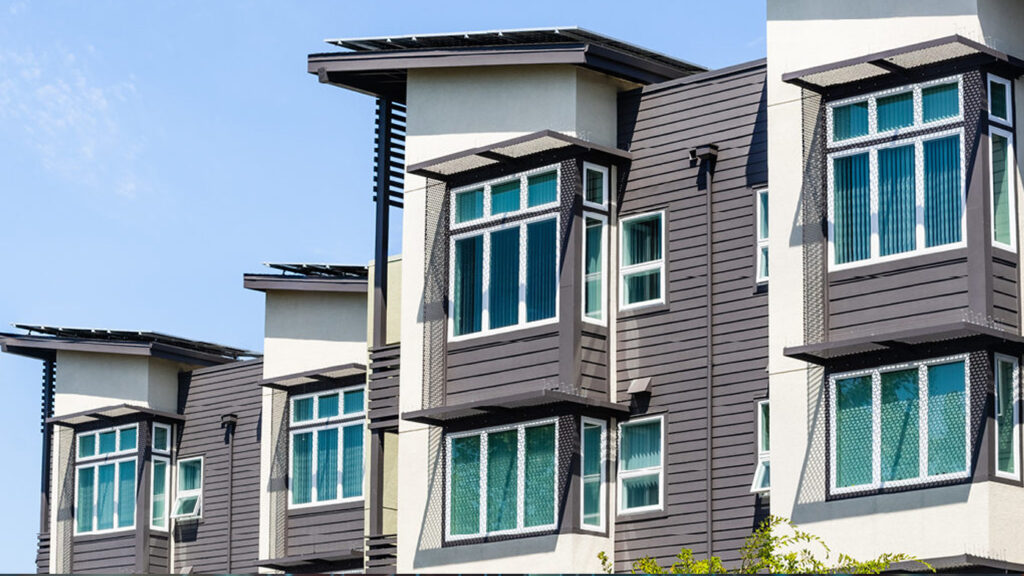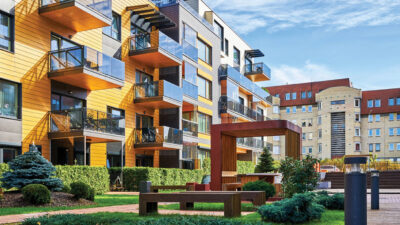The rise of multifamily housing developments continues, as does the resistance to these developments. A simple Google search of “multifamily developments” garners results like “Do rentals bring down property values?” and “How will new development impact home values?” It’s clear that many perceptions of multifamily developments popping up in suburbia are negative. But do any of these negative perceptions actually hold water?
Myth #1: Higher Crime Rates
In a previous blog, we explored a few human elements that are constraining multifamily development, and discussed how the opposition to this type of housing is tied, in large part, to the myth that areas with multifamily units have higher crime rates when compared to areas with single-family housing.
But in fact, this idea is merely a perception based on how crime rates are reported. A study conducted by the Arizona Multifamily Housing Association concluded that the perception of more crime around multifamily communities comes from the practice of reporting stats based on the count of police calls by address. An apartment property with 100+ units at the same address may be wrongly compared to one single-family residence. Per the Arizona Multifamily Housing’s study, “When police data is analyzed on a per unit basis, the rate of police activity in apartment communities is no worse than single family subdivisions, and in many cases, lower than single-family residential areas.”
Myth #2: A Burden on School Districts
Opponents to multifamily housing also cite the burden these developments create on the school districts they’re located in. However, the data between family owner-occupied homes and apartment complexes says otherwise. When looking at a study conducted by the American Housing Survey, 100 family owner-occupied homes included 51 school-aged children on average, and 100-unit apartment complexes averaged just 31 children. This makes sense when you think about it — apartments are typically more attractive to single people, couples without children and empty nesters. The gap actually widens when taking new construction into account. Data from the same survey shows an average of 64 children per 100 new single-family households in comparison to 29 children per 100 new apartment units.
Myth #3: Lower Home Values
Perhaps the most widely assumed fact is that home values will be negatively impacted by multifamily developments taking up residence nearby. This is another often-assumed myth. The U.S. Census Bureau found that working communities with multifamily dwellings actually have higher property values than working communities without them. The average value of single-family residential homes was highest in working communities with the most multifamily units, in comparison to communities with only single-family residential properties. “Multifamily developments tend to follow the jobs,” says Will Mathews, Colliers’ managing director and platform leader of the East Region Multifamily Advisory Group. “Wherever there’s a large concentration of employees, there’s going to be more apartment communities.”
A 2010 study that examines the impact of mixed use/mixed income housing developments in the Richmond region, found that the home prices and assessments of nearby single-family homes were not adversely impacted by the presence of mixed income/mixed use developments. In fact, in many cases, the developments had a positive impact on those single-family neighborhoods.
Myth #4: Multifamily Investments are Too Expensive, Harder to Finance and Difficult to Occupy
There are also many misconceptions about the investment in multifamily developments as well. Many people believe that the cost of multifamily real estate is more expensive than traditional single-family homes. However, this is indeed not the case. If you compare the price of a single-family home and the price per unit of a multifamily dwelling, the price is actually much lower. Depending on what part of the country you’re looking at, you can buy a single-family house starting at around $100,000. However, in contrast, you could purchase a 20-unit building for around one million dollars, bringing the cost per unit at around $50,000, in this example. And guess what? That same 20-unit apartment building? Let’s say once you take it over, you raise the rent by $50 per month, negotiate with vendors to reduce your costs by $20 per month for the dumpster fee and shave 1% off the management fee. The end result: you’ll have an extra $12,240 a year plus the difference in the management fee.
There is also the assumption that because of the larger price tag, multifamily is harder to finance. However, regardless if one is investing in a single-family home or a multifamily development, the average investor won’t have all the money in cash, so in both cases a loan from the bank would be needed. Contrary to popular belief, it’s actually much easier to get approved for a mortgage on a multifamily property rather than a single-family home, because banks view multifamily properties as a safer income-producing investment.
Another misconception is that it is harder to keep multifamily real estate occupied. In both single-family and multifamily asset classes, the owner is responsible for keeping the building occupied at all times. In a single-family home, if you’re unable to find a tenant — for even as short as a month — it can become a major problem because you make zero income when the dwelling is unoccupied, and your cash flow can easily turn negative. In contrast, when you own an entire apartment building, even if you have one or two of your housing units vacant for a month or two, you with still be able to collect income from other tenants and maintain a positive cash flow. The vacancy rate is not as much of an issue for multifamily properties when compared to investing in single-family properties, making multifamily a safer and more secure investment.
Embrace Multifamily Properties
It’s unlikely that the negative misconceptions of multifamily properties will stop or slow down the trend of them coming to suburbia. The truth is, as urban cores get more and more densely populated, people — many of which will be millennials — will be moving to the outskirts, and they’ll look for the same conveniences of a downtown center. The denser the population is in the surrounding areas, the more conveniences that will come, such as public transportation, parks and green spaces, libraries, dining options and more. Single-family homeowners, school districts and investors, fear not — the apartment building under construction next door will likely work out much better for you than you may think.
This article was written by the U.S. Colliers Editorial Board, whose mission is to produce new and noteworthy commercial real estate thought leadership pieces to create conversation around proactive content. The Editorial Board focuses on CRE trends in the United States, and is comprised of Colliers marketing, research, communication and service line leaders.

 Colliers Insights Team
Colliers Insights Team

 Aaron Jodka
Aaron Jodka
